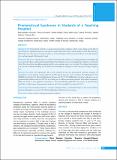Please use this identifier to cite or link to this item:
https://hdl.handle.net/20.500.14356/1396| Title: | Premenstrual Syndrome in Students of a Teaching Hospital |
| Authors: | Shrestha, Dhan Bahadur Shrestha, Shreya Dangol, Debika Aryal, Barun Babu Shrestha, Sabina Sapkota, Biplabi Rai, Sujeena |
| Citation: | ShresthaD. B., ShresthaS., DangolD., AryalB. B., ShresthaS., SapkotaB., & RaiS. (2019). Premenstrual Syndrome in Students of a Teaching Hospital. Journal of Nepal Health Research Council, 17(2), 253-257. https://doi.org/10.33314/jnhrc.v0i0.1213 |
| Issue Date: | 2019 |
| Publisher: | Nepal Health Research Council |
| Article Type: | Short Communication |
| Keywords: | Female students Nepal Premenstrual syndrome |
| Series/Report no.: | Apr-June, 2019;1213 |
| Abstract: | Abstract Background: Premenstrual syndrome is group of psychosomatic symptoms which occurs during second half of menstrual cycle. Significant number of reproductive aged females suffer from it with its impact on their daily activities. This study was conducted to assess the prevalence, severity and impacts of Premenstrual syndrome on female students of a teaching hospital of Kathmandu, Nepal. Methods: This cross-sectional study was conducted among female students of a teaching hospital from Kathmandu over a period of three months. Premenstrual Symptom Screening Tool was used to quantify the symptoms severity and their effect in activities. In addition; patient profile, socioeconomic status were recorded. The obtained information was entered in Statistical Package for Social Sciences and analyzed. Findings were then interpreted using chi-square test. Results: Out of the 285 respondents, 206 (72.3%) reported at least one premenstrual syndrome symptom of moderate to severe intensity among which 74 (25.9%) had at least one severe symptom. Six individuals (2.1%) fulfilled all criteria for Pre-Menstrual Dysphoric Disorder and 49 (17.2%) fulfilled the criteria for moderate to severe premenstrual syndrome and rest (80.7%) were having no or mild premenstrual syndrome with isolated symptoms. PMS was found to have significant association to menstrual bleeding (p?0.001) and severity of dysmenorrhea (p?0.001), family history of premenstrual syndrome (p=0.019) and physical activity (p=0.021). Conclusions: Premenstrual syndrome is common in female and has a considerable impact on day to day activities activities although its severe form Pre-Menstrual Dysphoric Disorder is less common. Keywords: Female students; Nepal; premenstrual syndrome. |
| Description: | Short Communication |
| URI: | http://103.69.126.140:8080/handle/20.500.14356/1396 |
| ISSN: | Print ISSN: 1727-5482; Online ISSN: 1999-6217 |
| Appears in Collections: | Vol. 17 No. 2 Issue 43 Apr - Jun 2019 |
Files in This Item:
| File | Description | Size | Format | |
|---|---|---|---|---|
| 1213-Manuscript-10755-1-10-20190804.pdf | Fulltext Download | 209.77 kB | Adobe PDF |  View/Open |
Items in DSpace are protected by copyright, with all rights reserved, unless otherwise indicated.
